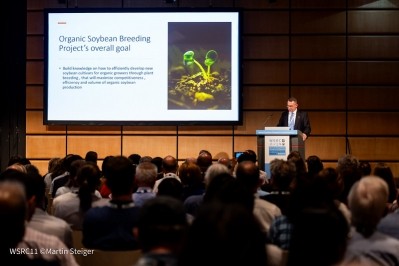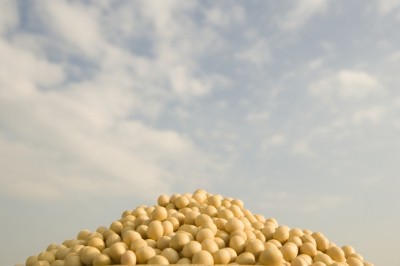Rethinking processing methods for sustainable use of European soybeans in broiler diets

The study, published in the journal, Animal Feed Science and Technology, was run under the EU funded Feed-a-Gene project.
Alternative processes for the production of expeller SBM from European grown soybeans were compared. Following grounding, soybeans were dehulled or not and then either extruded or flaked and cooked and finally pressed to extract the oil, resulting in four SBM products.
SBM products were then incorporated into broiler starter and grower diets to compare their effect on performance, digestibility as well as organ and gastrointestinal tract (GIT) development.
“This is, to our knowledge, the first time the combination of these processing and hulling methods has been applied,” said the authors, based at the Department of Agriculture, School of Natural and Environmental Sciences, Newcastle University, in the UK and the Institut du Porc (IPIF) in Toulouse, France.
The only differences observed were higher GIT development and lower carcass yield in dehulled in comparison to non-dehulled products, they found.
Objectives
The motivation for this study was the reliance of European broiler systems on imported SBM and the possibility of introducing novel SBM products from locally grown soybeans (Zander et al., 2016), as sustainability is an important aspect of the evaluation of alternative sources of protein for non-ruminant farm animals.
“Feed provision represents the poultry industry's biggest environmental issue (Leinonen et al., 2012; Tallentire et al., 2017), exacerbated by the inclusion of imported soybeans from South America where they are grown in vast monocultures on land obtained via deforestation (de Visser et al., 2014; Kebreab et al., 2016).
“The growing concern about the production systems of soy and impact that they have on deforestation and soil decline has led to initiatives for sustainable soy, like the RTRS soy (The Round Table on Responsible Soy, 2018) and the Danube Soy initiative (Donau Soja Association, 2018).
“Partially defatted SBM could have an additional economic advantage against imported SBM related to its non GMO character and its local origin (Le Cadre et al., 2015).”
Standard processing
The classical processing of soybeans involves dehulling, defatting with hexane, treatment with equate ethanol under vacuum to eliminate soluble carbohydrates, and drying with ethanol. However, hexane is extremely flammable and non-renewable, and is regulated as a hazardous air pollutant (O'Quinn, et al., 1997), said the authors.
In addition, they noted that solvent extraction requires a considerable capital investment, a consistent supply of soybeans to operate continuously throughout and uses a lot of energy (Pacheco et al., 2013).
“Although expeller extraction of soybeans is an alternative to the use of hexane, performance responses to expeller extracted SBM are rather inconsistent and suggest variations in nutritional value depending on the seed source and the process used (Karr-Lilienthal et al., 2006; Opapeju et al., 2006).”
Hypothesis
Based on the analyzed soybean potassium hydroxide, KOH solubility index and trypsin inhibitor units (TIU; mg/kg) the team hypothesized that diets incorporating the dehulled, flaked and cooked SBM product would result in superior performance and digestibility.
“Furthermore, we hypothesized that hull presence would penalize performance variables, due to the potential effects of the increased fibrous content deriving from soy hulls on GIT development and nutrient digestibility.”
The study
The soybeans were grown near Toulouse in France; yielding around 3000 kg/ha; they were harvested in September 2015.
Some 4,200 kg of soybeans was processed at the OLEAD technology platform in Pessac, France, following the methods detailed by Quinsac et al. (2012) to produce flaked-cooked-pressed SBM with hulls (831 kg), or without hulls (634 kg), and extruded-pressed SBM with hulls (708 kg) or without hulls (718 kg).
The beans were either extruded using single-screw extrusion at 140 °C at around 100 kg/h, or cooked at 150 °C for 3600 s after flaking with contra-rotating smooth cylinders. All beans were then pressed to extract the oil and the quality of the SBMs was determined, they added.
In summary, the team said the two processing methods use were Extrusion-pressing (E) vs Flaking-pressing-cooking (F) × 2 hulling methods - with hulls (H) vs no hulls (NH).
Following processing of the soybeans, the SBM products were transported to UK for their incorporation to the starter and grower broiler diets.
Parameters tested
The variables measured included average daily gain (ADG), average daily feed intake (ADFI), feed conversion ratio, apparent ileal dry matter (DM) and crude protein (CP) digestibility, jejunal histomorphometry at d14 and d28 and ileal digesta viscosity at d28 of age.
In addition, the researchers assessed carcass and carcass part yield, organ weight, and empty gastrointestinal tract weight and length per small intestinal segment at d28.
Findings
The processing method did not affect any of the variables evaluated, said the team.
On the other hand, they observed hull presence increased ADFI over the starter period, but not over the grower period. They also saw the presence of hulls increased proventriculus, gizzard and jejunum weight, and reduced carcass yield at d28 of age, likely due to the higher fiber content.
The method of processing and hulling significantly interacted ADFI and ADG at the end of the starter period, being highest for the E/H treatment, but overall broiler performance was similar between dietary treatments, reported the experts.
Small intestinal architecture and DM and CP digestibility were not affected by dietary treatments at either d14 or d28 post hatch, they added.
Although there was some variation in soybean protein solubility and trypsin inhibitors amongst SBM products, these factors did not appear to affect any of the measured variables.
Concluding, the researchers said all four methods of production resulted in comparable results in relation to performance variables.
Hull removal did not confer a significant advantage, aside from increased carcass yield, possibly due to the adaptive growth of the gizzard and proventriculus.
The crushing costs and net margins of both E and F processing methods are similar, but a flaking cooking pressing unit can also be used for sunflower and rapeseed meal oil extraction, bringing additional benefits (Quinsac et al., 2012). The E process, though, was more effective than F for de-oiling the meals.
They saw that all combinations of preparation and processing methods resulted in acceptable levels for KOH protein solubility index and residual trypsin inhibitor activity, even though E had been shown to be less effective than F for deactivation of trypsin inhibitors in the previous work of Quinsac et al. (2012), they said.
“Both processing methods of locally produced soybeans resulted in products which equally promoted broiler performance over the grower and the overall growing period.
“Although there were some differences in KOH solubility and TIU levels, these were poor predictors of DM and ileal CP digestibility.
“Hulled products resulted in similar performance, which could be ascribed to their effect on proximal GIT development. This nonetheless was achieved at an additional cost; slightly higher proportions of the hulled products were used to achieve similar CP content.”
We reported on the achievements to date of the Feed-a-Gene project back in December.
Source: Animal Feed Science and Technology
DOI: https://doi.org/10.1016/j.anifeedsci.2019.03.010
Title: Combining alternative processing methods for European soybeans to be used in broiler diets
Authors: P Sakkas, E Royer, S Smith, I Oikeh, I Kyriazakis













